The World: In the Face of Crises, Global Progress against Hunger Has Stalled
Global Hunger Remains Too High, and Progress on Reducing Hunger Has Stagnated
-
Global hunger remains too high, and progress on reducing hunger has largely stalled. The 2023 global GHI score is 18.3—considered moderate—down less than one point from the 2015 global score of 19.1. The share of people globally who are undernourished actually rose from 7.5 percent in 2017 to 9.2 percent in 2022, reaching about 735 million.
-
This stagnation relative to 2015 largely reflects the combined effects of overlapping crises, including the COVID-19 pandemic, the Russia-Ukraine war, economic stagnation, the impacts of climate change, and the intractable conflicts facing many countries of the world. Together, these crises have led to a cost-of-living crisis and exhausted the coping capacity of many countries, especially those where hunger was already high.
People were already struggling with the impact of COVID-19, then came the Russia-Ukraine war, which affected the price of food—that has made the situation worse. In these times of crisis, it’s difficult to eat three meals a day. People are struggling to eat one meal or maybe two at best. It is different from normal times without conflict.
Mohamed Ali Mohamed (age 20), Somalia
-
Rates of undernourishment, child stunting, child wasting, and child mortality—the four indicators used to calculate GHI scores—are all projected to fall short of the targets for 2030 set by the Sustainable Development Goals (SDGs).
Shocks and Crises Have Hit Some Regions, Countries, and Groups Especially Hard
-
The crises have aggravated inequalities between regions, countries, and groups. While some countries have weathered them relatively well, others have experienced deepening hunger and nutrition problems.
-
Less resilient regions, countries, and communities are expected to experience lasting hunger and nutrition setbacks and stand less prepared for future crises. Although the global effects of the COVID-19 pandemic, the Russia-Ukraine war, and higher food prices may be easing somewhat in 2023, climate conditions are worsening, and the price of food is still unaffordable for people in many areas.
-
Low- and middle-income countries have been particularly hard hit. Underlying factors such as inequality, state fragility, poor governance, and chronic poverty can make it difficult for countries to recover from the barrage of crises.
-
Youth in low- and middle-income countries are especially vulnerable to food security and nutrition crises. Today’s youth not only are affected by the current food crises but will also shoulder the burden of the looming disasters if concerted action is not taken.
The Regions: Cause for Concern in All World Regions
Figure 1.3
REGIONAL 2000, 2008, 2015, AND 2023 GLOBAL HUNGER INDEX SCORES
Note: See Appendix A for data sources. The regional and global GHI scores are calculated using regional and global aggregates for each indicator and the formula described in Appendix A. The regional and global aggregates for each indicator are calculated as population-weighted averages, using the indicator values reported in Appendix B. For countries lacking undernourishment data, provisional estimates provided by the Food and Agriculture Organization of the United Nations (FAO) were used to calculate aggregates only but are not reported in Appendix B. Appendix D shows which countries are included in each region.
Hunger Is Highest in South Asia and Africa South of the Sahara
-
South Asia and Africa South of the Sahara each have a GHI score of 27.0, indicating serious hunger. For the past two decades, these two regions have consistently had the highest levels of hunger. While both regions achieved considerable progress between 2000 and 2015, progress has nearly halted since 2015, reflecting the trend seen for the world as a whole.
-
Africa South of the Sahara has the highest level of undernourishment of any region, at 21.7 percent—a sizable increase compared with 16.8 percent in 2010–2012. Africa South of the Sahara also has the highest child mortality rate of any region, at 7.4 percent.
-
West Asia and North Africa is the region with the third-highest hunger level according to 2023 GHI scores. With a 2023 GHI score of 11.9, the region’s hunger level is considered moderate.
-
The increase in GHI scores for Latin America and the Caribbean between 2015 and 2023 is particularly troubling. It is the only region whose GHI scores have increased in this period.
-
East and Southeast Asia, dominated by populous China, has the second-lowest 2023 GHI score of any region in the report.
-
The region with the lowest 2023 GHI score is Europe and Central Asia, whose score of 6.0 is considered low.
-
Even in regions not covered by the GHI, such as North America and parts of Europe, food insecurity continues to pose a challenge.
The Countries: Too Many Countries Still Suffer from Hunger
Despite Global Progress in Reducing Hunger since 2000, Hunger Is Still Serious or Alarming in 43 Countries
-
Nine countries have alarming levels of hunger. Six countries are designated as alarming based on their 2023 GHI scores: Central African Republic, Democratic Republic of Congo, Lesotho, Madagascar, Niger, and Yemen. Three additional countries with insufficient data for the calculation of GHI scores are provisionally designated as alarming based on other known factors: Burundi, Somalia, and South Sudan.
-
Many countries are experiencing severe hunger in 2023, with the situation expected to worsen throughout the year. The countries at the highest level of concern for 2023 are Afghanistan, Haiti, Nigeria, Somalia, South Sudan, Sudan, and Yemen, as well as Burkina Faso and Mali.
Most of the time, conflict is the root cause of hunger in our community. I am a farmer, and when conflict breaks out, we all flee, and I have to leave my field and crops behind. Wherever we end up, we are newcomers. We have no fields, no reserves. This always makes us vulnerable. We have left everything behind in our home village.
Ruth Yumba (age 20), Democratic Republic of the Congo (name changed for security reasons)
Our school is located in the area that is constantly affected by food insecurity due to climatic changes. This usually has a very negative impact on children’s education, especially school attendance.
Clémence Kwizera (age 43), Burundi
One thing relates to the other. When the routes are blocked because of the armed gangs, women vendors can’t go through, and therefore the food goes to waste and then the ones who have food sell it more expensively. When the reserves run out, we can’t get more nutritious food.
Alexis Lourdrona (age 21), Haiti
Undernourishment and Child Undernutrition Are Extremely High in Some Countries
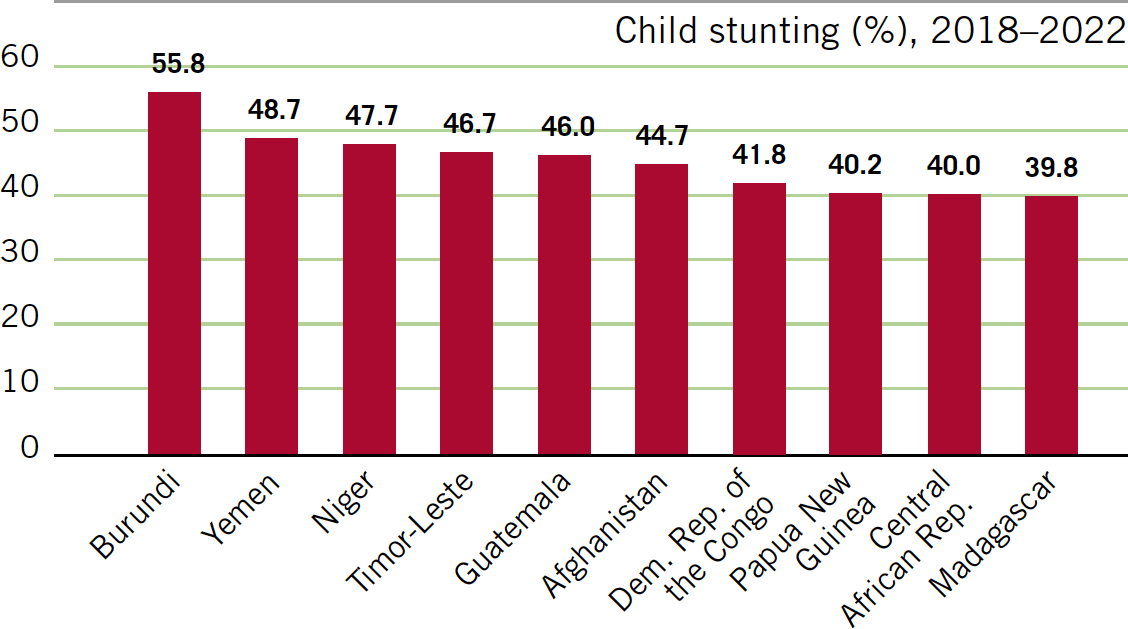
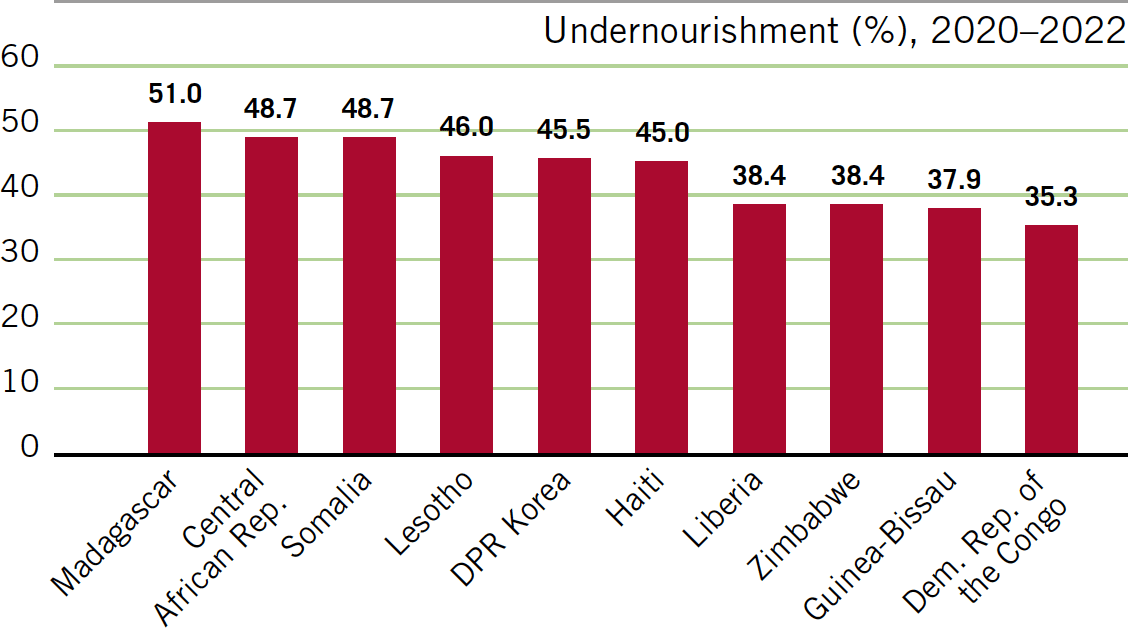
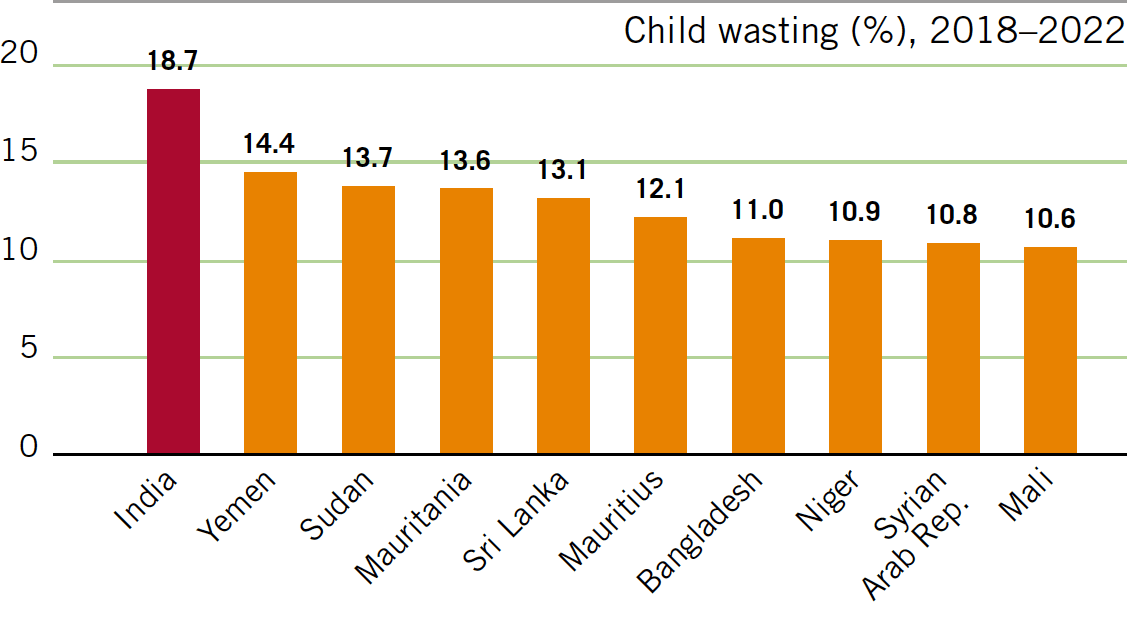
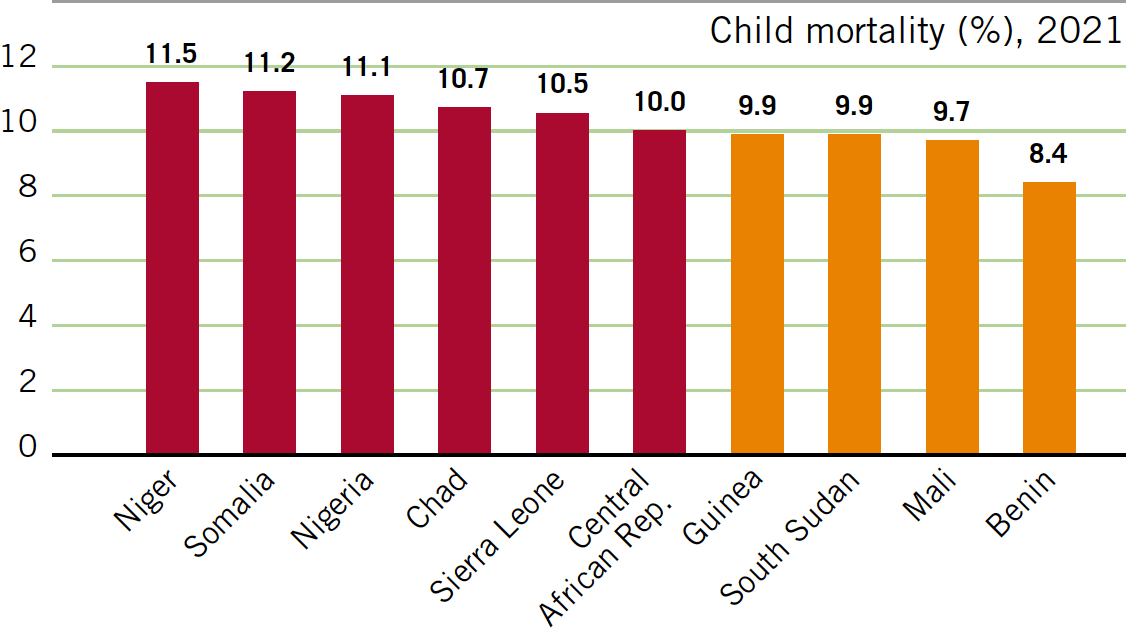

But There Are Also Examples of Progress and Hope
Figure 1.4
2023 GHI SCORES AND PROGRESS SINCE 2000
Note: This figure illustrates the change in GHI scores since 2000 in absolute values. It features countries where data are available to calculate 2000 and 2023 GHI scores and where 2023 GHI scores show moderate, serious, alarming, or extremely alarming hunger levels. Some likely poor performers may not appear due to missing data.
-
Seven countries whose 2000 GHI scores indicated extremely alarming hunger levels—Angola, Chad, Ethiopia, Niger, Sierra Leone, Somalia, and Zambia—have all made progress since then. According to the 2023 GHI scores, five of these countries have made enough headway to reduce their hunger levels to serious, and Niger’s 2023 GHI score, at 35.1, is very near the serious category. Somalia, however, is provisionally designated as alarming.
Food Insecurity and Malnutrition Jeopardize the Life Chances of Youth
-
Youth are “emerging into adulthood in a context of inherently unequal and unsustainable food systems that fail to deliver food and nutrition security and that are highly vulnerable to climate change and environmental degradation,” as described in this year's essay, “Beyond 2030: Youth, Food Systems, and a Future of Food Sovereignty.”
-
Youth—the period of adolescence and early adulthood—is a key developmental stage when a proper diet and nutrition are critical. Other than early childhood, adolescence is the period of most rapid physical growth and development.
-
Food insecurity and hunger are formidable barriers facing youth during this critical period of their lives.
-
In addition to food access and availability, social factors can affect the food choices young people make.
-
The prominence of high-calorie, low-nutrient foods in modern diets puts youth at risk of the double burden of malnutrition—namely, overweight/obesity accompanied by micronutrient deficiencies.
-
One important consideration related to the nutritional needs of young women is the potential for motherhood and the implications of their nutrition status for both themselves and their children.
My hope is that our children will grow up healthy, less sick, and that the role of women can be strengthened in all areas, thus ensuring a better South Sudan and a more successful next generation.
Joyce Abalo (age 34), South Sudan
Conclusion
The right to food is violated for millions of people each day, and a robust political commitment to inclusive governance of food systems is needed to ensure this injustice is ended once and for all.
-
The crises the world has faced in recent years have undermined progress toward ending hunger, and the future portends a continuing onslaught of crises for which the world is not prepared. Underpinning this unfortunate expectation is the acceleration of climate change, which is likely to generate not only direct, weather-related crises such as droughts, flooding, extreme storms, and heat but also indirect crises such as pandemics, conflict, and displacement—all of which can contribute to hunger without adept responses. Given the vast inequality in today’s world, these burdens will be disproportionately shouldered by those who already suffer the most from hunger, poverty, conflict, and poor governance.
-
At the global level, endless summits and ambitious declarations have pledged to address hunger and malnutrition and their underlying causes, but if these commitments are never translated into action, the next generation will face increasing levels of food and nutrition insecurity. It is more critical than ever to break this intergenerational cycle, and it is increasingly apparent that this will require the holistic transformation of food systems and improvements to governance structures, energy and infrastructure systems, social protection systems, and more—all of which are currently inadequate to achieve Zero Hunger.

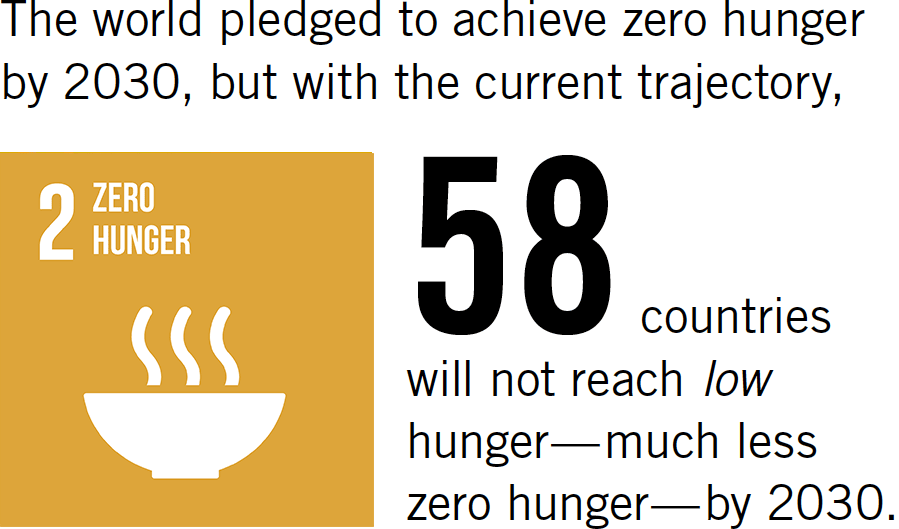
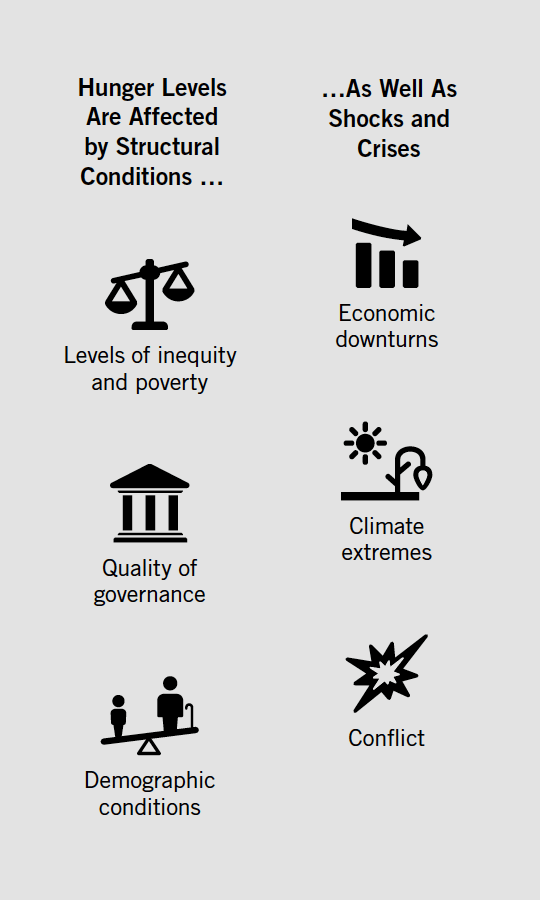
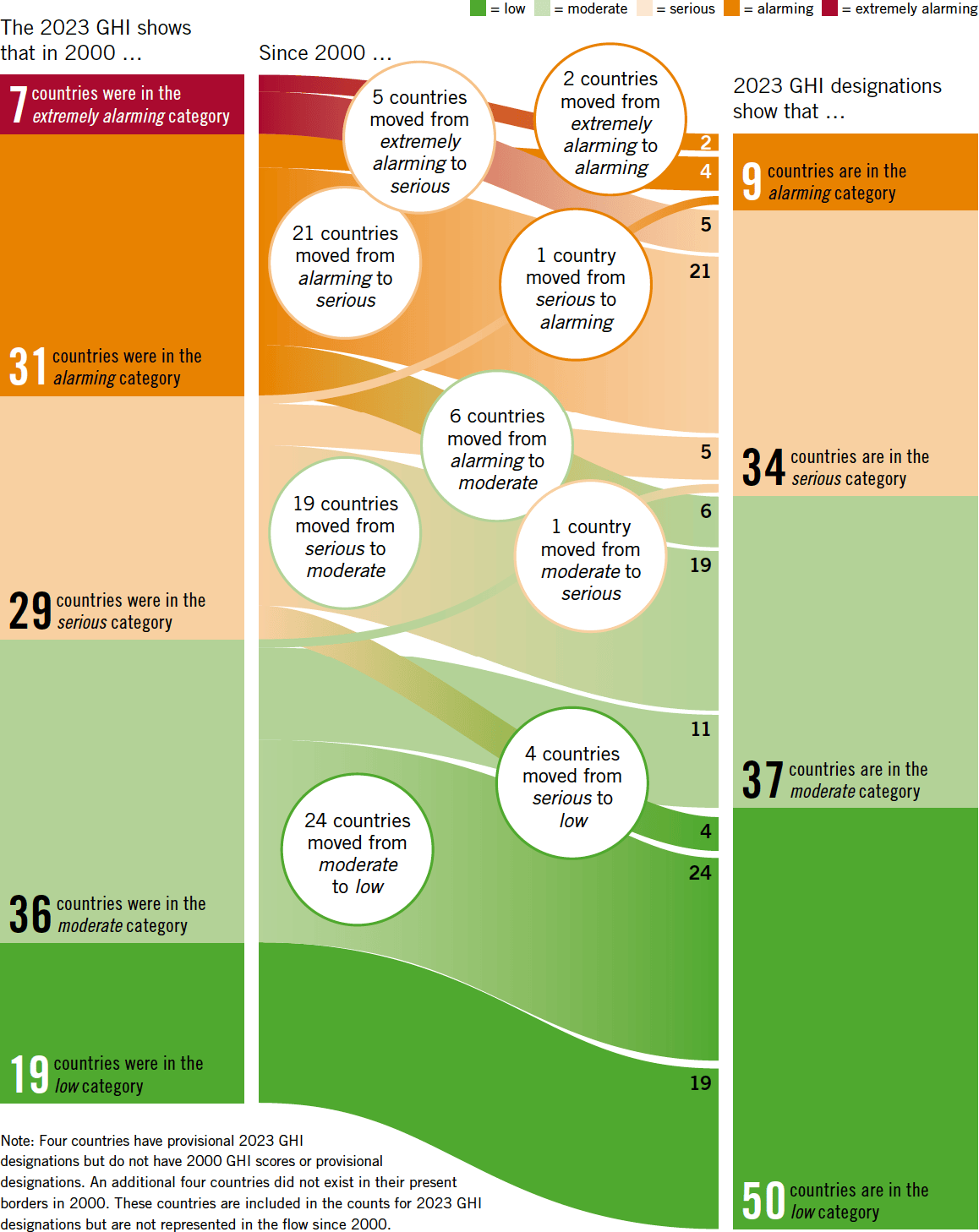
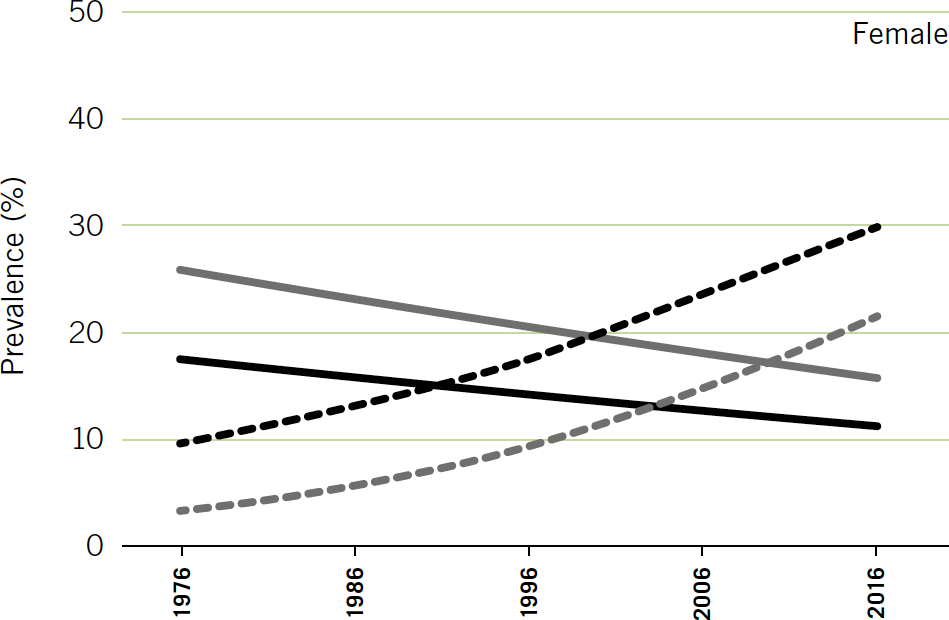


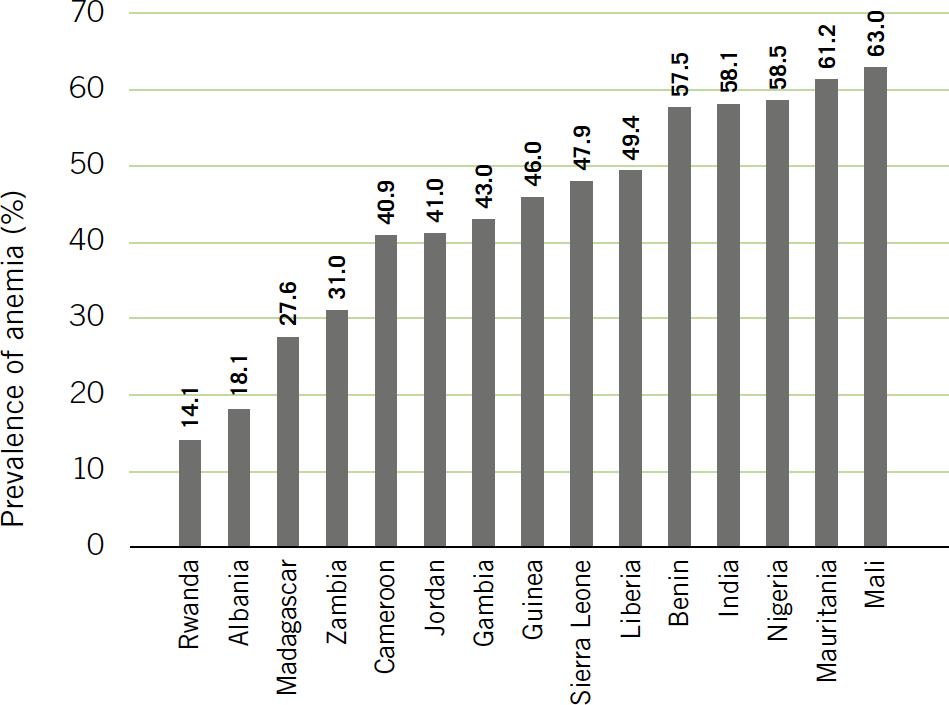 Source: ICF (2023). Note: Countries shown are those with data collected since 2018 and included in ICF (2023). Data are shown for the most recent year available.
Source: ICF (2023). Note: Countries shown are those with data collected since 2018 and included in ICF (2023). Data are shown for the most recent year available.